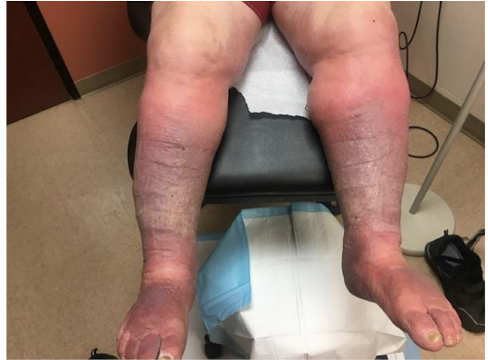Lecture 8: Edema in Wound Management
1/27
There's no tags or description
Looks like no tags are added yet.
Name | Mastery | Learn | Test | Matching | Spaced |
|---|
No study sessions yet.
28 Terms
Define Edema:
Abnormal accumulation of interstitial tissue fluid

Edema Basics:
Edema commonly occurs where in the body?
What type of edema is this called
Legs and Feet
Peripheral Edema
Edema Basics:
What are the 7 main types of edema that occur in the legs?
What is Venous Edema caused by?
Types:
Venous
Cardiac
Lymphedema
Inflammatory
Idiopathic
Hypoproteinaemic
Renal
Venous Dysfunction
Edema Basics:
Pitting Edema =
Non-Pitting Edema =
Early Edema
Progressed w Fibrosis
What is the 6 main tretaments for Edema?
Medical team managing medical conditions
Heart Failure, Kidney Disease
Compression
Exercise
Elevation and moving often during dat
Skin care
Manual lymph drainage if indicated
Compression Benefits:
Compression reduces the diameter of veins causing what?
Endothelial cells to become tighter therefore reducing fluid leakage from the veins
Compression Benefits:
Compression produces an increase in what? and reduces what?
Compression facilitates what?
Increase in blood flow towards the heart
Reduces venous reflux
Lymphatic fluid movement
The Degree of Compression is determined by what 5 main factors?
Elasticity of bandage
Number of bandage layers
Shape and size of limb
Skill and technique of bandager
Nature of physical activity undertaken by patient
Compression Pressure:
What does Laplace’s Law show?
Sub-bandage pressure:
DIRECTLY proportional to bandage tension and number of layers
BUT
INVERSELY proportional to the limb circumference to which it is applied and the bandage width
Compression Pressure:
When tension is applied evenly:
There will be greater pressure at the _______ radius rather than ______ radius due to what?
Greater pressure on SMALLER rather than LARGER
Due to:
Distribution of the same tension over the greater or lesser area
Compression Pressure:
Increased Bandage Tension =
Increased Number of Bandage Layers =
Increased Leg Circumference =
Increased Bandage Width =
Increased Bandage Tension = Increased Sub Bandage Pressure
Increased Number of Bandage Layers = Increased Sub Bandage Pressure
Increased Leg Circumference = Decreased Sub Bandage Pressure
Increased Bandage Width = Decreased Sub Bandage Pressure
Bandage Types:
2 Main Categories
Example
Long Stretch
Ace Wrap
Short Stretch
Unna Boot
Bandage Type:
Long Stretch Bandage is used for what?
Short Stretch Bandage is SAFER than….
LS:
Used for more aggressive compression
So not use by itself and on pts w fragile veins/skin
SS:
Safer than Long Stretch due to LESS extensibility and therefore less tension to limb
What is Resting Pressure?
Pressure bandage excerts on tissues at rest
What is Working Pressure?
Pressure bandage exerts against working muscles
Ex. When walking, moving around, exercise
NOT when standing
Bandage Type:
Describe Long Stretch Bandage Characteristics: (5)
High resting pressure
Stiff like boot
Low working pressure
Higher risk of damage
> 140% extensibility
Made of polyurethane
Bandage Type
Describe Short Stretch Bandage Characteristics:
Low resting pressure
High working pressure
Lower risk of damage
~ 60% extensibility
Made of cotton fibersC
Compression Precautions (Pt 1 - 4)
DM
PAD
Acute Cellulitis/Infection
Neuropathy
Compression Precautions (Pt 2 - 3)
Acute Heart Failure
Low Ejection Fraction
Fragile Skin
Can cause bruising
Compression Contraindications (2)
ABI < 0.5
High Compression (30-40 mmHg) w ABI < 0.8
Compression Progression:
Open Wounds » Closed Wounds
Open:
Compression Wraps
May consider Velcro Compression garment but NOT ideal
Closed:
Compression Stockings OR Compression Garments
Compression Stockings are INDICATED for legs w what? (5)
Hx of Ulcers
Hx of DVT
Hx of Cellulitis
Edema or Risk of Edema
Varicosities or Spider Veins
Compression Stockings are NOT INDICATED for legs w what?
Open wounds
Use compression wrapping instead for open wound
Compression Garment
4 main classes of mmHg:
15-20 mmHg
Pts who cannot tolerate higher level or cannot put garment on
Class 1: 20-30 mmHg
Most Common
Class 2: 30-40 mmHg
Recommended for DVT
Class 3: 40-50 mmHg
More severe lymph conditions
What to include in pt education: (3)
Edema progression
Importance and purpose of wraps and compression stockings
Monitoring for changes
heart failure, cellulitis, signs od arterial probs
Pt Education:
What to instruct pt regarding compression garment use?
How long and how many break per day to elevate legs above heart?
Compression Garment Use:
Wear during waking hours, whenever out of bed
Wash regularly
Take 45-60 min break 3x/day
Pt Education:
Limit what 2 activities?
Move legs how often while sitting?
Limit
Prolonged Standing (> 10 min)
Prolonged Sitting w/o Getting Up (> 30 min)
Every 15-20 min